|
|

Established in 834 and located in Kora-cho town, Saimyoji is a Tendai Buddhist temple and the northern-most one in the Koto Sanzan Temple Trio. The main temple hall, designated as Japan's first National Treasure, houses statues of gods with a carving of the 12 Oriental Zodiac signs on the head. Accessible by bus from Amago Station on the Omi Railway Line.
|
|

In mid-November, a shuttle bus runs to Saimyoji and two other temples of the Koto Sanzan Temple Trio of Tendai temples. All three are famous for fall foliage.The shuttle bus starts from Hikone Station, west exit.
|
|

Front gate. This is where you pay the admission fee.
|
|

Colorful autumn path to Saimyoji Temple.
|
|
|
|

Crossing the Meishin expressway. There's a bridge over a busy and noisy expressway which you cross to get to the other side of the temple grounds.
|
|

The path was a stunning showcase for autumn foilage.
|
|
|
|
|
|
|
|
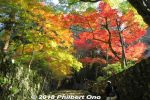
Saimyoji's autumn highlight is its stunning path to the temple.
|
|
|
|
|
|
|
|
|
|
|
|
|
|
|
|
|
|

Stairs to autumn heaven. Up to here, the path was just filled with colors. And more still awaited.
|
|
|
|
|
|
|
|
|
|
|
|
|

11-faced Kannon statue
|
|

Miniature Kannon
|
|
|
|
|
|
|
|
|

So beautiful in autumn!
|
|
|
|

Wedded cedar trees.
|
|

Wedded cedar trees.
|
|

Wedded cedar trees.
|
|
|

Nitenmon Gate to main temple (Hondo).
|
|

Nitenmon Gate.
|
|
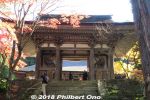
Nitenmon Gate.
|
|

Nitenmon Gate has small waraji straw sandals. Coins stuck in the sandals.
|
|

About the Niten gods guarding the gate.
|
|

Niten god
|
|

Niten god
|
|
|
|

Nitenmon Gate (rear).
|
|
|
|
|
|
|

Saimyoji Temple Hondo hall (National Treasure) in Kora, Shiga. 本堂
|
|

Saimyoji Temple Hondo hall (National Treasure)
|
|
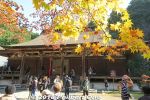
Saimyoji Temple Hondo hall (National Treasure)
|
|

Saimyoji Temple Hondo hall (National Treasure)
|
|

Saimyoji Temple Hondo hall (National Treasure).
|
|

Saimyoji Temple Hondo hall (National Treasure)
|
|

Saimyoji Temple Hondo hall (National Treasure)
|
|

Saimyoji Temple Hondo hall (National Treasure)
|
|

Saimyoji Temple Hondo hall (National Treasure)
|
|
|

Saimyoji Temple Hondo hall (National Treasure)
|
|

In 1571, Oda Nobunaga ordered Saimyoji to be burned down right after torching Enryakuji on Mt. Hiei. Fortunately, this Kamakura-Period main hall and the pagoda survived.
|
|

Saimyoji Temple Hondo hall (National Treasure)
|
|
|

View from Saimyoji Temple Hondo hall (National Treasure).
|
|

Saimyoji Temple Hondo hall (National Treasure)
|
|
|

Water basin
|
|

Water basin
|
|

Saimyoji temple bell
|
|

Saimyoji temple bell accented with red maples.
|
|

Saimyoji's three-story pagoda, a National Treasure.
|
|
|
|
|
|
|
|
|
|
|
|
|
|
|
|
|
|

About the "ever-blooming" cherry tree (fudan-zakura).
|
|

"Ever-blooming" cherry tree (fudan-zakura) planted next to a tree showing fall colors. This special cherry tree blooms in Nov. during the fall colors. 不断桜
|
|
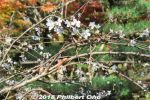
"Ever-blooming" cherry tree (fudan-zakura) in autumn.
|
|

"Ever-blooming" cherry tree (fudan-zakura) in autumn.
|
|
|
|
|
|
|
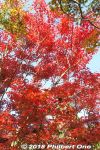
Red maple leaves.
|
|
|

Green pine tree.
|
|

About Horai-tei Garden.
|
|
|
|

Horai-tei Garden
|
|
|
|
|
|

Tree roots
|
|

Red maples towering above.
|
|
|
|
|
|
|
|
|
|
|
|
|
|
|
|
|
|

The following photos were taken years earlier. Something things look the same, others have changed. Map of temple grounds.Established in 834 and located in Kora-cho town, Saimyoji is a Tendai Buddhist temple and the northern-most one in the Koto Sanzan Temple Trio.
The main temple hall, designated as Japan's first National Treasure, houses statues of gods with a carving of the 12 Oriental Zodiac signs on the head. Accessible by bus from Amago Station on the Omi Railway Line.
|
|

Front gate. This is where you pay the admission fee of 500 yen. During fall, the autumn leaves are brilliant, and you can enter the three-story pagoda (National Treasure) to see the wall paintings. MAP
|
|

Soon after you enter the temple, you see this "continuously blooming" cherry tree (fudan-zakura) planted next to a tree showing fall colors. This special cherry tree blooms in Nov. during the fall colors. 不断桜
|
|

Cherry blossoms which bloom in Nov. Designated as a Natural Monument and Cultural Property of Shiga. 不断桜
|
|

Cherry blossoms which bloom in Nov. This is full bloom. Not as glorious as the cherries in spring, but unusual to see them in Nov. 不断桜
|
|

Crossing the Meishin expressway. There's a bridge over a busy and noisy expressway which you cross to get to the other side of the temple grounds.
|
|

The path was a stunning showcase for autumn foilage.
|
|

Incredibly beautiful
|
|
|
|

Autumn leaves and stone wall
|
|
|
|
|
|
|
|

Stairs to autumn heaven. Up to here, the path was just filled with colors. And more still awaited.
|
|

At the top of the stairs
|
|
|
|

Nitenmon Gate to main temple (Hondo)
|
|

View from gate
|
|

View from gate
|
|
|

Japan's first National Treasure undergoing renovation of the roof. Saimyoji temple's Hondo hall (National Treasure) in Kora, Shiga. 本堂In 1571, Oda Nobunaga ordered Saimyoji to be burned down right after scorching Enryakuji on Mt. Hiei. Fortunately, this Kamakura-Period main hall and the pagoda survived.
|
|

Saimyoji temple Hondo Hall (National Treasure) in Kora, Shiga. In 1571, Oda Nobunaga ordered Saimyoji to be burned down right after torching Enryakuji on Mt. Hiei. Fortunately, this Kamakura-Period main hall and the pagoda survived. 本堂
|
|

Temple grounds
|
|

Inside Saimyoji temple's Hondo hall.
|
|

Hondo grounds
|
|

Hondo grounds
|
|

3-story pagoda, a National TreasureIn 1571, Oda Nobunaga ordered Saimyoji to be burned down right after scorching Enryakuji on Mt. Hiei. Fortunately, this Kamakura-Period main hall and the pagoda survived. The pagoda is 23.7 meters high.
|
|

Oda Nobunaga burned Saimyoji right after scorching Enryakuji on Mt. Hiei. Fortunately, the main hall and the pagoda survived. 3-story pagoda, a National Treasure
|
|

3-story pagoda, a National Treasure
|
|

3-story pagoda, a National Treasure
|
|

Saimyoji's 3-story pagoda, a National Treasure.
|
|

During the peak autumn season in Nov., the public is allowed to enter the pagoda to view the precious paintings on the wooden walls and pillars.
|
|

Veil of autumn leaves. Only several people can fit inside the first floor of the pagoda at one time, so you may have to wait in line.
|
|

3-story pagoda and fall colors. Photography is not allowed inside, but I highly recommend going inside. Admission 1,000 yen.
|
|

Closeup of pagoda
|
|
|
|

Temple bell
|
|

Temple bell, donate 50 yen to ring it
|
|
|

11-faced Kannon statue
|
|

Miniature Kannon
|
|

Miniature Kannon. Pay money to have your name under one of them.
|
|

Horaitei garden
|
|

I thought the fall colors were most abundant at Saimyoji. We could also enter the 3-story pagoda, a National Treasure. (You cannot enter the pagoda at the other temples.)
|
|

Saimyoji was my favorite Koto Sanzan temple
|
|

Tourists come by the busloads
|
|

Convenient shuttle bus. Visit Kongorinji temple next.During the peak fall season from mid-Nov., you can buy an Omi Railway train/bus pass for only 1,800 yen to visit all three Koto Sanzan temples plus Eigenji Temple. Ride on the Omi Railway Line to the closest train station (Hikone or Yokaichi) and hop on a shuttle bus like this one to visit the Koto Sanzan Temple Trio, plus Eigenji. There's a shuttle bus every hour or so that shuttle between the four temples. The pass is good for 1 day.
|
|
|
|
|